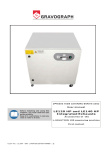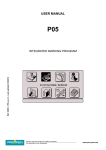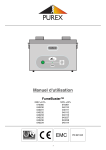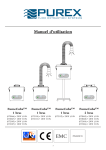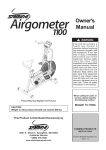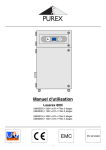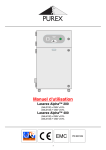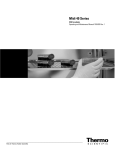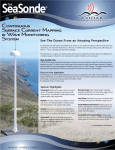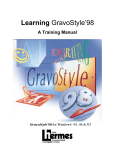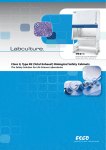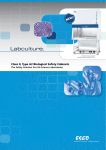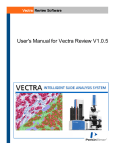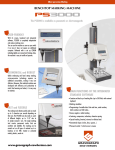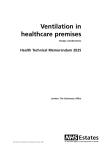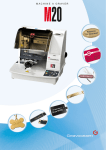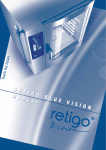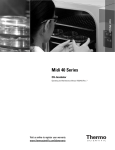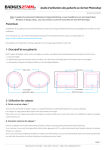Download LE150 HP Integrated Exhaust
Transcript
(Please read carefully before use) Before installing and using this machine, you must read this user guide carefully. Keep it in a safe place, in case you need to refer to it later. User manual LE150 HP Integrated Exhaust Accessories of the L-SOLUTION 100 / 100 Ex Laser engraving machines First contact G1282 701 - 06.2008 - ENG - (UPDATED EDITION NUMBER : 1) TYPE OF MACHINE MANUFACTURER : Exhaust System for the L-SOLUTION 100/100Ex LASER ENGRAVING MACHINES : PUREX INTERNATIONAL Ltd. FOR GRAVOGRAPH INDUSTRIE INTERNATIONAL BP 15 - Z.I. - 10600 LA CHAPELLE SAINT LUC - FRANCE Importer's address This publication and its contents are proprietary to Gravograph Industrie International (Gravograph), and are intended solely for the contractual use of Gravograph customers. While reasonable efforts have been made to assure the accuracy of this manual, Gravograph shall not be liable for errors contained herein or for incidental or consequential damage in connection with the furnishing, performance, or use of this material. Gravograph reserves the right to revise this manual and make changes from time to time without any obligation by Gravograph to notify anybody of such revision or changes. Gravograph can not be held liable for any problems arising out of the application or use of any products, circuits, or software described herein. Neither does it convey a license under its patent rights nor the patent rights of third parties. Gravograph provides no warranties whatsoever on any software used in connection with a Gravograph Laser Engraving System, express or implied. Neither does it guarantee software compatibility with any off-the-shelf software package or any software program that has not been written by Gravograph. Intended use of this system must be followed within the guidelines of this manual. In no event will Gravograph be liable for any damages caused, in whole or in part, by customer, or for any economic loss, physical injury, lost revenue, lost profits, lost savings or other indirect, incidental, special or consequential damages incurred by any person, even if Gravograph has been advised of the possibility of such damages or claims. Windows is a registered trademark of Microsoft Corporation. PostScript is a registered trademark of Adobe Systems Inc. (c) Gravograph Industrie International, 2008 All Rights Reserved. LE150 HP Integrated Exhaust . 2 First contact Summary Information about regulations..............................................................4 Warnings and safety instructions..........................................................5 Warnings......................................................................................................................................... 5 Safety instructions............................................................................................................................ 5 Introduction..........................................................................................6 What happens when lasing................................................................................................................. 6 Why use fume extraction................................................................................................................... 6 The integrated exhaust, LE150 HP....................................................................................................... 6 Composition of the Pack........................................................................6 Installing the Exhaust unit....................................................................7 To do before the first use................................................................................................................... 7 Positionning the Exhaust unit............................................................................................................. 7 Hose connection............................................................................................................................... 8 Electrical connection......................................................................................................................... 8 Input/Output.................................................................................................................................... 8 Control system......................................................................................9 (1) Switching the Exhaust ON/OFF...................................................................................................... 9 (2) Speed control............................................................................................................................. 9 (3) Exhaust starting up...................................................................................................................... 9 (4) Insufficient airflow....................................................................................................................... 9 Routine Maintenance...........................................................................10 Schedule....................................................................................................................................... 10 Circuit breaker tripped..................................................................................................................... 10 Consumables.......................................................................................10 Filtration and changing filters.............................................................11 Multi-stage filtration........................................................................................................................ 11 Changing filters - Security................................................................................................................ 12 Opening the cabinet doors............................................................................................................... 12 Changing the "Cascade" pre-filter 1................................................................................................... 13 Changing the "Cascade" pre-filter 2................................................................................................... 14 Changing the carbon pads................................................................................................................ 15 Changing the HEPA filter.................................................................................................................. 16 Changing the activated carbon......................................................................................................... 17 Trouble shooting.................................................................................18 Reclose circuit breakers................................................................................................................... 18 Technical specifications.......................................................................19 First contact LE150 HP Integrated Exhaust . 3 Information about regulations This hardware was designed and build in conformity with the relevant EC marking and EEC directives : • "Machine Security" Directive 98/37/EEC (22/06/98). • "Electromagnetic compatibility" Directive 2004/108/EC • "Low Voltage" Directive 2006/95/EC The different fuses of this device comply with the IEC 127-2 norm (International Electric Committee). Conforms to the following: EC directives (91/263)(92/31)(98/37) Uses the following British Standards: (BS EN 292-1)(BS EN 292-2)(BS EN 60204-1)(BS EN 294)(BS EN 50 081-1) Main filter assembly: (BS EN ISO 2144)(BS EN ISO 536)(BS EN ISO 1924)(BS 5295)(UNI 7833) (BS 4400) Pre-filter assembly: UNI 7832 Mechanical assembly: (BS 8000/99)(IEC 60034/1)(BS 5000)(VDE 0530) Enclosure ratings: (IP 54)(IP 55)(IP 56) Overload protection unit: (BS EN 60947/4/1) Control relay: (BS 5424)(VDE 0660) Blower: (IEC 6000/34)(IP54) This symbol indicates that once this equipment has reached the end of its useful life, it must not be disposed of with non-sorted municipal waste, in accordance with the European Directive 2002/96/EC. The equipment must be disposed of at an appropriate collection point for processing, sorting, and recycling of Waste Electrical and Electronic Equipment (DEEE). The elements which compose Electrical and Electronic Equipment may contain substances which have harmful effects on the environment or on human health. By following these instructions, you are helping the environment, contributing to the preservation of our natural resources, and protecting human health. LE150 HP Integrated Exhaust . 4 First Contact Warnings and safety instructions Warnings • Always isolate the system from the mains power supply before opening the exhaust cover. • Disposable gloves and a dust mask are supplied with replacement filters/prefilters. They should be used when removing filters and disposed of with the used filter in the bag which is also provided. Safety glasses should also be worn. • Filters are manufactured from non-toxic materials. • Filters and prefilters are not re-usable and no attempt should be made to clean them. • Used filters and prefilters should be disposed of in accordance with local laws and regulations. The company and its agents disclaim all liability and responsibility for any harm, damage, contamination or injury caused by inappropriate or unlawful disposal. • The LE150 HP exhausts use high pressure blowers, which may cause inferior filters to burst, allowing hazardous fumes into the workplace. Do not use filters that have only been tested to BS3928, BS5295 or AS208C as these standards are flow checks only and are designed to test filters used in general dust extraction and air conditioning. • Consult the local regulations concerning fume extraction systems, as these may be subject to requirements including; periodic checks by authorised agencies, re-issue of certificates of compliance or equivalents etc. Consult your supplier if in doubt. • Consult your supplier for information on maintenance agreements that will ensure conformance to local regulations. Safety instructions When using electro devices, the following fundamental safety measures must be observed in order to protect against electric shock, injury and fire: • Please read and observe these instructions before using the device! • Keep these operating and maintenance instructions carefully! • Do not use the device for suction extraction of easily ignitable or explosive gases! • Do not use the device in explosive zones. • Do not use the device for suction extraction of burning or glowing substances such as, for example, cigarettes, matches, metallic dust or shavings, paper, cleaning cloths etc.! • Do not use the device for suction extraction of burning or inflammable materials such as, for example, oils or oil mist, grease, separating agents (e.g. silicone spray), cleaning agents etc.! • Do not use the device for suction extraction of aggressive media! • Do not use the device for suction extraction of any form of liquid! • Do not use the device for suction extraction of organic substances without the written authorisation of the manufacturer! • Protect the connection plugs against heat, moisture, oil and sharp edges! • Pay attention to the permitted mains voltage! (Observe information on the label attached to the cabinet rear!) • Use only Gravograph replacement parts! • Do not operate the device without a filter insert! • Disconnect the filter device from the mains power supply prior to opening! • The blowing out opening must not be covered or blocked off! • Always pay attention to ensuring that the device is standing firmly and that the brakes on the guide rolls are applied! • When cleaning and servicing the device, when replacing parts or when converting to another function, the filter device must be disconnected from the mains power supply! • The filter inserts cannot be regenerated! • Dispose of the filter in accordance with the statutory regulations in force in the country of installation in order to contribute to the preservation of the environment! • When using an external filter control, the control cable must be examined for damage prior to all work! • The device must not be used if the control cable is not in perfect condition! • The mains lead of the device must be checked at regular intervals for signs of damage! • The device must not be used if the mains lead is not in perfect condition! • Do not use the filter device if one or more parts of the device are defective, are missing or are damaged. In any such case, please contact your Gravograph supplier. First Contact LE150 HP Integrated Exhaust . 5 Introduction What happens when lasing When a laser beam is applied to the surface of a material, several conditions can occur: • The high temperatures generated cause the air near to the contact point to expand generally back in the direction of the lens (for stationary products) • The laser beam causes incineration, vaporisation, melting and softening of the material depending upon the distance from the contact point. The rapidly expanding gases pick up and carry the removable particles and droplets at relatively high velocities away from the product material • The contaminants released consist of the products of complete and partial combustion, including possible oxides of the base material, along with a wide variety of gases, in some cases noxious i.e. benzene, phosgene Why use fume extraction Lasers are used to mark, engrave and cut a wide variety of materials. During these processes, gases, vapours and particulate matter (dust) are released as airborne contaminants which, in most cases can be classified as harmful if inhaled. Airborne particles also cause problems for the laser if they are allowed to be deposited on the lens, or remain in the marking area, when loss of definition of the laser beam can occur. Deposition of particulates within the laser enclosure can result in contamination of the product and also the need for regular cleaning of associated operating equipment. The only practical method of overcoming the above problems is to remove these airborne contaminants as quickly and completely as possible by the provision of a fume extraction and filtration system. The integrated exhaust, LE150 HP The Integrated Exhaust LE150 HP was designed especially for Gravograph applications : compatible with the processing on noxious material, such as rubber and acrylic, without any repulsive odour. It runs at dB level of 69 ! It offers you these capabilities : LE150 HP Quantity of active carbon 40 liters Pre-filter 1 - Number of pleat 6 Pre-filter 2 -Number of pleat 5 Air compressor Integrated Use Standard and Intensive Marking, Engraving and cutting Application Rubber stamp sheets Wood cutting Acrylic cutting Plastic engraving Wood engraving The following guidelines are intended to assist the engineer when installing laser marking extraction systems LE150 HP and to optimise their performance with the Laser engraving machines L-SOLUTION 100 and L-SOLUTION 100 Ex. Composition of the Pack (A) 1 Exhaust (with 4 wheels) (LE150 HP) (B) 1 Input/Output cord (1500mm) for the exhaust (Extraction function) (C) 1 Black pipe hose 100mm/length 700mm with 2 clamps (D) 1 Power cord (E) 1 Input/Output cord (500mm) for the compressor of the exhaust (Air assist function) (F) 1 Air assist pipe 4x2mm/length 800mm (J) 1 CD User manual (K) 1 Kit "Gloves and Mask" LE150 HP Integrated Exhaust . 6 First Contact Installing the Exhaust unit The LASER engraving machine L-SOLUTION 100/100 Ex is placed directly on the Exhaust unit. The filters are already inserted inside the exhaust. To do before the first use • Open the door of the exhaust system (see procedure page 12) • Remove the 2 wedges (C1) and (C2) • Check that all the filters are the right place : (1) : "CASCADE" pre-filter F6 (6 pleats) (2) : "CASCADE" pre-filter F8 (5 pleats) (3) : Activated carbon filter (4) : HEPA filter (8) : Carbon pads Positioning the Exhaust unit The Exhaust unit should be placed with sufficient space allowed for the following access: Front: Rear: Control panel , internal maintenance , replacing filters. Air in, Cooling air in, cooling air out, power cable, circuit breaker, exhaust air, interface cable (optional) Once in position, lock the two front castors. First Contact LE150 HP Integrated Exhaust . 7 Hose connection Incorrect connection or layout of hose can cause poor airflow, blockages and potentially dangerous build up of fume. Use the shortest length of hose possible and keep bends to a minimum. Your supplier can advise you of appropriate diameters and layouts of hose for your particular application. Ensure all connections are properly sealed and that there are no kinks in the hose. Once secured in position, connect the hose (C) to the inlet on the machine by pushing the hose onto the inlet and by using 2 supplied clamps. (A) Integrated Exhaust (B) Input/Output cord of the exhaust (extractor) - connected on (N2) (C) Black pipe hose (100mm/length 700mm) with 2 clamps - connected on (N8) (D) Power cord (E) Input/Output cord of the compressor (H) (air assist function) - connected on (N3) (F) Air Assist Tube - connected on (N7) (G) Air Outlet (H) Integrated compressor (air assist function) Electrical connection Prior to connecting the power supply (D), ensure that the voltage, frequency and power requirements are correct as shown on the label (L1) attached to the cabinet rear. Various connection methods are available to order. This material is «class 1». The mains plug MUST always be connected to a neutral socket and comply with the regulations in force in the country of installation. If you do not have a plug of this type, have one installed by an approved electrician. Under no circumstances should you depart from this instruction. Input/Output Connect the Input/Output cord (B) between the Laser engraving machine and the Integrated Exhaust. The Integrated Exhaust (LE150 HP) is controlled directly by the Laser engraving machines L-SOLUTION 100 / 100 Ex using this I/O cord (B). Press engraving. on the control panel of the L-SOLUTION 100 / 100 Ex in order to activate the Integrated Exhaust when Connect the Input/Output cord (E) between the Laser engraving machine and the Integrated Exhaust. The Integrated compressor of the LE150 HP is controlled directly by the Laser engraving machines L-SOLUTION 100 / 100 Ex using this I/O cord (E) (Air Assist Function). The Input/Output configuration is Output n°1 = 4 : OUT1 LE150 HP Integrated Exhaust . 8 4 First Contact Control system (1) Switching the Exhaust ON/OFF To switch the Exhaust ON/OFF press button (1) which will illuminate green when ON. The green LED (3) will illuminate while the exhaust starts up. (2) Speed Control Speed Control To increase the vacuum turn the speed control knob (2) clockwise. Turning the speed control knob anti-clockwise reduces the vacuum. What Vacuum to Set? The lowest vacuum level possible should be used so that the fume produced by the process is just drawn into the capture nozzle. Please note that setting the vacuum level unnecessarily high will reduce filter life. (3) Exhaust starting up This green LED illuminates in order to indicate that the exhaust is starting up. The arrest (PAUSE) and the start (START) of the extraction are controlled by the LASER engraving machine. (4) Insufficient airflow This red LED illuminates in order to indicate that the airflow is insufficient. The procedure is as follows: 1. Switch off the exhaust system 2. Check all hose, seals and connections for leaks and check the vacuum sensor tube for blockage and also check the following points for debris build up: - Flexible hose and any pipework - Air inlet - Sense line (inside the air inlet) 2. If the red LED is still lit despite all the checks described above, increase the airflow with the speed control knob (2) until the red LED turns off (the problem is resolved). 3. If the red LED is still lit with airflow set maximum , it means that one or more filters must be replaced (see "Filtration and changing filters" page 11) : 3a. Open the doors of the exhaust (see procedure page 12) and check that all the filters are the right place. 3b. First replace the Cascade pre-filter 1 (see procedure page 13). Set the minimum airflow before re-starting the exhaust. If the red LED is still lit increase the airflow until the red LED turns off (the problem is resolved). 3c. If the red LED is still lit with airflow set maximum and with a new Cascade pre-filter 1, the pre-filter 2 or the 2 carbon pads or the HEPA filtre must be replaced (procedure described pages 14/15/16). Once everything is in place, Set the minimum airflow and re-start the exhaust. If the red LED is still lit, increase the airflow with the speed control knob (2) until the red LED turns off (the problem is resolved). If the fault persists, contact your supplier. First Contact LE150 HP Integrated Exhaust . 9 Routine maintenance Before carrying out any maintenance, unplug the mains supply cable. The mains cable should always be replaced if it is damaged in any way : flattened, nicked, cracked etc..., or if there are bare wires. Schedule Primary maintenance is filter replacement and the machine control system will indicate when this is required. All hoses should be checked for clogging periodically. To ensure the smooth running of the extraction machine and associated equipment, please perform the following periodic checks: Daily - Visually check that the fumes are being drawn into the extraction point and check the status of the green and red LEDs The activated carbon must be changed at least once a year. Circuit breaker tripped May indicate a serious fault. Consult your supplier. (see "Reclose circuit breakers" page 18) Consumables 49281 • HEPA filter - LE150 HP : - HEPA H13 - 4.2 kg (Ref. 49281) 49282 • Activated carbon filters - LE150 HP : - 40 liters carbon box - 26 kg (Ref. 49282) - 20 liters carbon box - 15 kg (Ref. 49283) - Carbon pad - 180 g (Ref. 49284) - Standard carbon bag - 25 kg (Ref. 49285) 49286 449287 • Cascade pre-filters 1 : - LE150 HP 6 PLEAT CASCADE Prefilter - 920 g (Ref. 49286) - LE150 HP 3 PLEAT CASCADE Prefilter - 600 g (Ref. 49287) 50113 • Cascade pre-filter 2 : - LE150 HP 5 PLEAT CASCADE Prefilter - 660 g LE150 HP Integrated Exhaust . 10 (Ref. 50113) First Contact Filtration and changing filters Operation of the filter installation must be interrupted during changing of the filter cartridge. Filter change and disposal must only be carried out in well ventilated areas and with a corresponding breathing mask! Our recommendation: Half breathing mask DIN EN 141/143 protection level P3. Changing of the filters should be carried out exclusively by a correspondingly trained member of staff! Dispose of the filter in accordance with the statutory regulations in force in the country of installation in order to contribute to the preservation of the environment. Manual knocking out, washing out or blowing out of the filters leads to destruction of the filter medium. The harmful substances penetrate into the room air. Disconnect the exhaust from the mains power supply before opening the cabinet door. Multi-stage filtration Integrated Exhaust LE150 HP The machine employs a multi-stage filtration process. Contaminated air enters the machine from the process (01) and is passed through a first Cascade pre-filter (1) which removes larger particles at approximately 1 micron in size and above. Then it is passed (02) through a second pre-filter (2). This prevents premature blockage of the next filters (3) and (4). Two carbon pads (8) to protect the activated carbon filter and the HEPA filter. The refillable activated carbon filter (3) removes toxic gases and the bad odors. The activated carbon must be changed at least once a year. The HEPA filter (4) removes 99.997% of particles larger than 0.3 microns in size and 95% of particles over 0.01 microns in size. The purified air is now returned to the workplace (5). First Contact Important note : Always check the following points for debris build up before changing any filter. This avoids false alerts related to airflow. • Flexible hose and any pipework • Air inlet • Sense line (inside the air inlet) LE150 HP Integrated Exhaust . 11 Changing filters - Security The machine will warn you with visible alert if a filter (except for the activated carbon filter) is blocked (see control system). The red LED illuminates. Always change the Cascade pre-filter first (unless recently changed) and restart the machine. If the alert continues, check and if necessary, change the carbon pads (8) or/and the HEPA filter (4). Take care when removing filters as they are heavy. Always wear the protective gloves and mask provided and dispose of them with the used filters in the bag provided. Changing of the filters should be carried out exclusively by a correspondingly trained member of staff! Operation of the filter installation must be interrupted during changing of the filter cartridge. Goggles, gloves and mask must be worn when changing filters (label (A9)). Filter change and disposal must only be carried out in well-ventilated areas and with a corresponding breathing mask! Our recommendation: Half breathing mask DIN EN 141/143 protection level P3. Dispose of the filter in accordance with the statutory regulations in force in the country of installation in order to contribute to the preservation of the environment. The company and its agents disclaim all liability and responsability for any harm, damage, contamination or injury caused by inappropriate or unlaw ful disposal. Manual knocking out, washing out or blowing out of the filters leads to destruction of the filter medium. The harmful substances penetrate into the room air. Disconnect the exhaust from the mains power supply before opening the cabinet door. Opening the cabinet doors It is important that the following procedure is followed when opening the doors. Failure to do so will result in your process operating without extraction which is an Occupational Health & Safety hazard. The correct procedure is as follows: • Ensure your process is stopped (the green LED is OFF) • Switch off your Integrated Exhaust at the control panel (see control system). The green button (1) must not be illuminated • Disconnect your Integrated Exhaust from the mains. • Turn the two door locks (A1) (pre-filters door (D1)) or the two door locks (A2)(filters door (D2)) on the front of the machine 180 degrees (anti-clockwise) • Open the door (D1) or (D2) LE150 HP Integrated Exhaust . 12 First Contact Changing the Cascade pre-filter 1 Integrated Exhaust LE150 HP The Cascade pre-filter (1) is situated in the compartment on the left, next to the Cascade pre-filter (2) (Door (D1)). The procedure to change it is as follows: • Disconnect your Integrated Exhaust from the mains Goggles, gloves and mask must be worn when changing filters (label (A9)) (see "Changing filters - Security" page 12). • Open the door (D1) (see procedure page 12) • Pull the filter (1) off the air inlet (01) and remove it • Insert the new filter, pushing the hole in the filter over the air inlet (01) Use only Gravograph Cascade pre-filters! The company and its agents disclaim all liability and responsability for the use of any other pre-filter as specified in "Consumables" page 10. • Close and lock the door (D1) • Set the minimum airflow • Connect your filter device to the mains and restart the machine • If the red LED is still lit increase the airflow until the red LED turns off • If the red LED is still lit with airflow set maximum and with a new Cascade pre-filter 1, the Cascade pre-filter 2 or the carbon pads or the HEPA filter must be replaced. First Contact LE150 HP Integrated Exhaust . 13 Changing the Cascade pre-filter 2 Integrated Exhaust LE150 HP The Cascade pre-filter (2) is situated in the compartment on the left, next to the Cascade pre-filter (1) (Door (D1)). The procedure to change it is as follows: • Disconnect your Integrated Exhaust from the mains Goggles, gloves and mask must be worn when changing filters (label (A9)) (see "Changing filters - Security" page 12). • Open the door (D1) (see procedure page 12) • Pull the filter (2) off the air inlet (02) and remove it • Insert the new filter, pushing the hole in the filter over the air inlet (02) Use only Gravograph Cascade pre-filters! The company and its agents disclaim all liability and responsability for the use of any other pre-filter as specified in "Consumables" page 10. • Close and lock the door (D1) • Set the minimum airflow • Connect your filter device to the mains and restart the machine • If the red LED is still lit increase the airflow until the red LED turns off • If the red LED is still lit with airflow set maximum and with new Cascade pre-filters (1) and (2), the 2 carbon pads or the HEPA filter must be replaced LE150 HP Integrated Exhaust . 14 First Contact Changing the carbon pads Integrated Exhaust LE150 HP The carbon pads (8) are situated in the compartment on the right (Door (D2)), one below the HEPA filter (4) and the other below the activated carbon filter (3). The procedure to change the carbon pads is as follows: • Disconnect your Integrated Exhaust from the mains Goggles, gloves and mask must be worn when changing filters (label (A9)) (see "Changing filters - Security" page 12). • Open the door (D2) (see procedure page 12) • Turn the filter locking handle (6) 180º anti-clockwise so that it is horizontal and in the filter unlocked position • The filters (3,4) will drop slightly to allow release • Remove the filters (3,4) by sliding it towards you and remove it completely from the exhaust. Be careful not to damage the seals (J). • Check the carbon pads status and replace them if necessary. Use only Gravograph main filters! The company and its agents disclaim all liability and responsability for the use of any other pre-filter as specified in "Consumables" page 10. • If their status are good, replace the HEPA filter (step (•*) of the procedure "Changing the HEPA filter" next page) • Otherwise once the carbon pads replaced, insert the filter (3,4) (completely) into the machine ensuring that the airflow arrows on the labels (7) are pointing up. Be careful not to damage the seals (J). • Turn the filter locking handle 180º clockwise so that it is horizontal and in the filter locked position • Close and lock the door (D2) • Set the minimum airflow • Connect your filter device to the mains and restart the machine • If the red LED is still lit increase the airflow until the red LED turns off • If the red LED is still lit with airflow set maximumand with new Cascade pre-filters (1)&(2) and 2 carbon pads replaced, the HEPA must be replaced (see the procedure "Changing the HEPA filter" next page) First Contact LE150 HP Integrated Exhaust . 15 Changing the HEPA filter Integrated Exhaust LE150 HP The HEPA filter (4) is situated in the compartment on the right (Door (D2)), over the other filters (8) and (3). The procedure to change it is as follows: • Disconnect your Integrated Exhaust from the mains Goggles, gloves and mask must be worn when changing filters (label (A9)) (see "Changing filters - Security" page 12). • Open the door (D2) (see procedure page 12) • Turn the filter locking handle (6) 180º anti-clockwise so that it is horizontal and in the filter unlocked position • The filters (3,4) will drop slightly to allow release • Remove the filters (3,4) by sliding it towards you and remove it completely from the exhaust. Be careful not to damage the seals (J). •* Replace the HEPA filter (4) ensuring that the part number on the old filter matches the part number on the new filter (label (7)). Use only Gravograph HEPA filters! The company and its agents disclaim all liability and responsability for the use of any other HEPA filter as specified in "Consumables" page 10. • Insert (completely) the filters (3,4) into the exhaust ensuring that the airflow arrows on the label (7) are pointing up. Be careful not to damage the seals (J). • Turn the filter locking handle 180º clockwise so that it is horizontal and in the filter locked position • Close and lock the door (D2) Set the minimum airflow • Connect your filter device to the mains and restart the machine • If the red LED is still lit increase the airflow until the red LED turns off • If the red LED is still lit with airflow set maximum and with all the filters certified as OK, contact your supplier LE150 HP Integrated Exhaust . 16 First Contact Changing the activated carbon Integrated Exhaust LE150 HP The activated carbon filter (3) is situated in the compartment on the right (Door (D2)), below the HEPA filter (4). The activated carbon must be changed at least once a year.The procedure to change it is as follows: • Disconnect your Integrated Exhaust from the mains Goggles, gloves and mask must be worn when changing filters (label (A9)) (see "Changing filters - Security" page 12). • Open the door (D2) (see procedure page 12) • Turn the filter locking handle (6) 180º anti-clockwise so that it is horizontal and in the filter unlocked position • The filters (3,4) will drop slightly to allow release • Remove the filters (3,4) by sliding it towards you and remove it completely from the exhaust. Be careful not to damage the seals (J). • Loosen the screws (S) and remove the circular plates (P) • Empty the carbon box (3). The used activated carbon should be disposed of in the bag provided for that purpose. • Fill the carbon box (3) only with Gravograph activated carbon (25kg standard carbon bag ref. 49285) Use only Gravograph activated carbon! The company and its agents disclaim all liability and responsability for the use of any other activated carbon as specified in "Consumables" page 10. • Replace the plates (P) and tighten the screws (S) • Insert (completely) the filters (3,4) into the machine ensuring that the airflow arrows on the labels (7) are pointing up. Be careful not to damage the seals (J). • Turn the filter locking handle 180º clockwise so that it is horizontal and in the filter locked position • Close and lock the door (D2) • Connect your filter device to the mains and restart the machine. First Contact LE150 HP Integrated Exhaust . 17 Trouble Shooting Red LED ON The Cascade Pre-filters and/or HEPA filter may be blocked. One or both of these filters may be blocked. Unless recently changed you should first replace the Cascade pre-filter (1) and re-start the machine. If the red LED does not switch off you should then replace the Cascade pre-filter (2) and re-start the machine. If the red LED does not switch off you should then replace the carbon pads or the HEPA filter. If these filters have been recently changed then another fault may be causing the LED to illuminate. See below. Red LED ON and filters have been certified OK Connecting hose may have a leak or the vacuum sensor Check all hose, seals and connections for leaks and check tubes in the air inlet may be blocked. the vacuum sensor tube for blockage. The alarm has triggered and the blower stops. The thermal cutout on the blower may have engaged. Check the cooling vents both inside and out. Switch off mains power and allow the blower to cool. If this does not remedy the fault please contact your supplier. Electrical faults Blower does not function or has developed a fault. Control signal to/from interfaced equipment is incorrect or absent. LED is not illuminated Procedure : - Check all cables and connections inside and out. - Ensure the power supply matches the requirements of the machine. - Check circuit breakers. - Switch off main power, check all vents for blockages, allow motor to cool and restart. - An electrical part may need replacement, contact supplier. Filter faults Odour or particles in exhaust air. The activated carbon filter may be damaged, fitted incorrectly or missing. The activated carbon of the filter may be exhausted and should be replaced. The activated carbon must be changed at least once a year. Airflow insufficient to remove fume when the filters are not blocked. Possible airflow leak or a blockage. Check all hose, seals and connections for leaks and check the vacuum sensor tube for blockage. If OK then increase airflow level. The HEPA filter has a shorter than expected life. Large particles may be bypassing the particle pre-filters. Check the particle pre-filters which may be damaged or missing. All information in this publication is subject to change without prior notice. Reclose circuit breakers To engage the circuit breakers, press on (C1) or/and (C2) LE150 HP Integrated Exhaust . 18 First Contact Technical Specifications Vers 1.0 - 02/06/2008 LE150 HP 40 l - 230 V Dimension (wxdxh) 40 l - 115 V 700x970x700 mm Net weight 106 kg Shipping dimensions 1140 x 850 x 1030 mm Shipping weight 139 kg 400 m3/h Max. air flow Max. static pressure 10 kPa Motor Brushless Noise level 69 dBA Pre-Filter 1 Needle felt F6 Dimensions 540x230x600 mm Net weight 0.92 kg Surface 2.6 m2 Filtration class F6 Number of pleats 6 Pre-Filter 2 Dimensions 5 pockets - 540x200 mm Net weight 0.66 kg Surface 1 m2 Filtration class F8 Number of pleats 5 Activated carbon filter Dimensions 560x365x200 mm Net weight 26 kg Activated carbon 40 liters Carbon pads Needle felt F6 x 2 Dimensions 560x365x5 mm Net weight 0.09 kg Surface 0.2 m2 Filtration class F6 HEPA filter Dimensions 560x365x80 mm Net weight HEPA filter Air compressor Frequency 4.2 kg H13 - 6.14 m 2 - 99.997% > 0.3 µm - 95% > 0.01 µm 230 V ±10% 115 V ±10% 50/60 Hz 50/60 Hz Pressure 0.9 bars Air flow 45 l/min Air inlet and outlet Voltage Type of protection 100 mm 230 V ±10% By two reclose circuit breakers Wattage Frequency First Contact 115 V ±10% 1.6 kW 50/60 Hz 50/60 Hz Switch (On/Off) Yes Motor speed variation Yes "Insufficient airflow" warning system (filter blocked warning) Yes LE150 HP Integrated Exhaust . 19



















